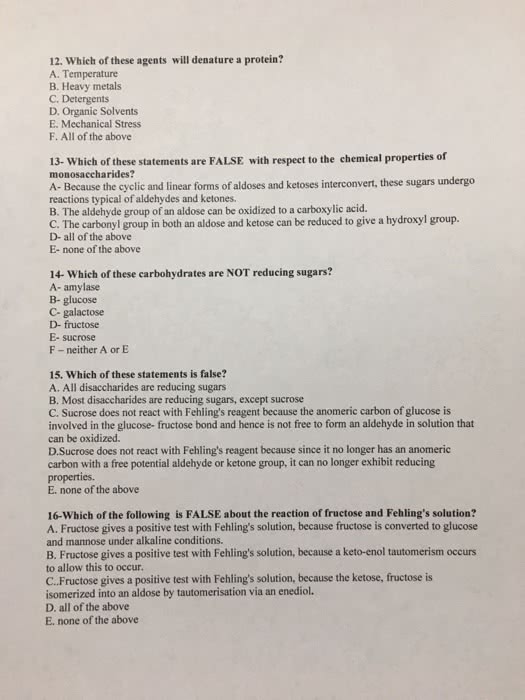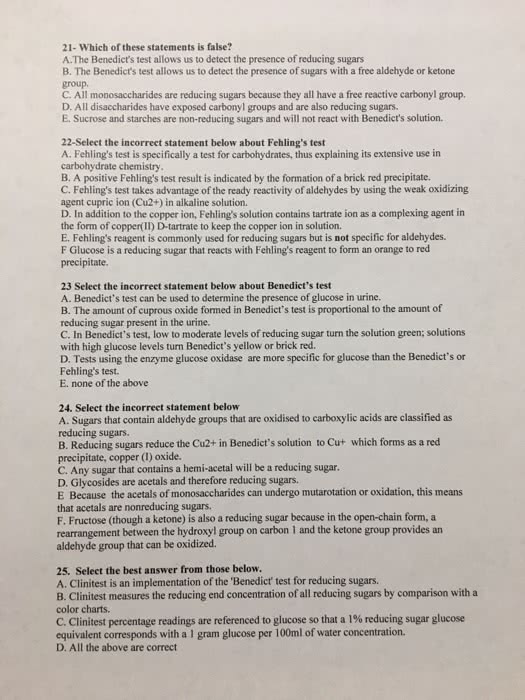NUTR 3210 Lecture Notes - Lecture 5: Fischer Projection, Stereoisomerism, Dextrorotation And Levorotation

Unit 05
Carbohydrates
Video
Carbohydrates Classification & Structure
Transcript
Slide 1
In this video, we will provide an overview of carbohydrate classification and
structure.
Slide 2
To begin, let’s consider what carbohydrates are. While carbohydrates were
originally considered as being hydrates of carbon, which would mean that they
had carbons attached to molecules of water, this is untrue. Carbohydrates do
consist of carbon, hydrogen and oxygen, but their structures include aldehyde
and ketone functional groups to which hydroxyl, or OH groups, are attached. This
means that they are more appropriately defined as polyhydroxyaldehydes and
ketones. There are several types of carbohydrates that are classified according
to the complexity of their structure. The simplest carbohydrates are the
monosaccharides, of which the most common dietary forms are glucose,
fructose, and galactose. Glucose is very widely distributed in food, while fructose
occurs naturally in fruit, and galactose in milk. Monosaccharides can be
considered as carbohydrate monomers, and as we will see later in this unit, this
is the form in which they are absorbed by the body. The dimer form of
carbohydrates are the disaccharides. Here, there are two monosaccharides that
are bonded together by glycosidic bonds. The three forms of disaccharides are
lactose, which is found in milk and consists of a monomer of glucose bound to a
monomer of galactose; sucrose, which is found in cane sugar and consists of a
monomer of glucose bound to a monomer of fructose; and maltose, which isn’t
really found naturally in food but rather represents a digestion product of bigger
carbohydrates, and consists of a monomer of glucose bound to another
monomer of glucose. Like maltose, oligosaccharides, which are short polymers
of carbohydrates, are also not really found in nature, but we nonetheless like to
put them in their own category, where they contain between three and nine
monosaccharides. Polysaccharides are much longer and more complex
polymers. Plant polysaccharides include amylose, which is comprised of linear
chains of glucose monomers bound by glycosidic bonds in an alpha 1,4 linkage,
and amylopectin, which similarly has linear chains of glucose monomers bound
by glycosidic bonds in an alpha 1,4 linkage but also has branch points with alpha
1,6 bonds, giving it a more complex branched structure. Together, the amylose
and amylopectin in plants is called starch, a common name that you are probably
Page 1 of 5
find more resources at oneclass.com
find more resources at oneclass.com

familiar with. The form of polysaccharide found in animals is glycogen, which like
amylopectin, has both linear and branched chains of glucose monomers,
although glycogen has a denser structure than amylopectin.
Slide 3
The functional groups found in carbohydrates are important to consider because
of their influence on carbohydrate chemistry. Carbohydrates mainly contain
aldehyde and ketone functional groups, which are similar in structure. In an
aldehyde, the carbonyl carbon is bonded to a hydrogen and a single R group,
where in a ketone, the carbonyl carbon is bonded to two R groups. This changes
the location of the functional group, such that in an aldehyde, the functional
group is terminal in the molecule, while in a ketone, it is somewhere within the
molecule. The carbonyl carbon is also referred to as its own functional group, the
carbonyl group, and is present in several functional groups. As we move forward
into carbohydrate nomenclature, you will see that when you number carbons in a
carbohydrate, you locate the carbonyl carbon and for aldehydes, number the
carbonyl carbon as number 1 (as the carbonyl group is placed at the top of the
molecule), and for ketones, the carbon nearest the carbonyl group is designated
as number 1.
Slide 4
Carbohydrate nomenclature is therefore dependent on the type of functional
group present as well as the number of carbons in the molecule. In the examples
shown here, we see examples of three molecules, each of which contains an
aldehyde functional group, and which have three, five, and six carbons
respectively. Going back to basic chemistry, the prefix for three is tri, for five is
penta, and for six is hexa. So, these three molecules are named as an aldotriose,
for a molecule with three carbons and an aldehyde functional group;
aldopentose, for a molecule with five carbons and an aldehyde functional group;
and aldohexose, for a molecule with six carbons and an aldehyde functional
group. If the functional groups in these molecules were ketones, the names
would instead by ketotriose, ketopentose, and ketohexose. Other numbers of
carbons are possible, but three, five and six are shown here as they are the most
significant. Three carbon carbohydrates are seen in metabolism as metabolites
of glucose, five carbon carbohydrates are components of DNA and RNA, and six
carbon sugars are the most nutritionally significant. Soon, we will also see that
for nomenclature can include designation of different isomers related to
stereoisomerism. These nomenclature rules apply to monosaccharides, which is
all we will name in this course.
Slide 5
Carbohydrates can assume different structures based on their chemical
reactivity. While linear forms of monosaccharides are observed, these are
present in small amounts, as the reactivity of the carbonyl group makes the
Page 2 of 5
find more resources at oneclass.com
find more resources at oneclass.com
Document Summary
In this video, we will provide an overview of carbohydrate classification and structure. While carbohydrates were originally considered as being hydrates of carbon, which would mean that they had carbons attached to molecules of water, this is untrue. Carbohydrates do consist of carbon, hydrogen and oxygen, but their structures include aldehyde and ketone functional groups to which hydroxyl, or oh groups, are attached. This means that they are more appropriately defined as polyhydroxyaldehydes and ketones. There are several types of carbohydrates that are classified according to the complexity of their structure. The simplest carbohydrates are the monosaccharides, of which the most common dietary forms are glucose, fructose, and galactose. Glucose is very widely distributed in food, while fructose occurs naturally in fruit, and galactose in milk. Monosaccharides can be considered as carbohydrate monomers, and as we will see later in this unit, this is the form in which they are absorbed by the body.



